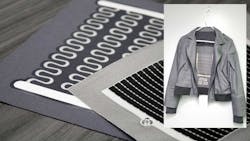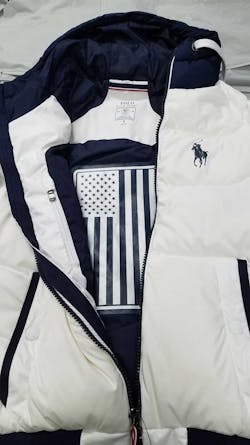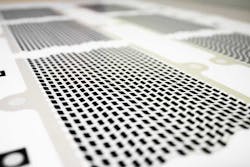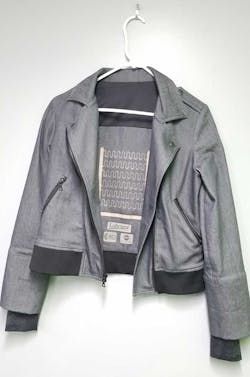Flexible printed heaters are a relatively new technology drawing the attention of product designers worldwide. They are being used in innovative thermal applications in industries including automotive, medical, athletics, aerospace, defense and utilities.
In the 2018 Winter Olympics, for example, the jackets designed by Ralph Lauren and worn by Team USA had built-in flexible printed heaters designed with help from Butler Technologies, Inc. Engineers at Butler overcame several technological hurdles while they were developing and fine-tuning the flexible heaters.
For instance, they struggled with establishing consistent print thickness for the conductive inks. The variability in the ink thickness and resistance caused inconsistencies in the heater’s performance. Another struggle was using repeatable screen-making processes and maintaining a consistent screen press set-up. This is critical to the heater’s operation.
The team also had a hard time accurately measuring the dry film thickness and electrical resistance during production runs. This is crucial in manufacturing consistent heaters.
Flex Heater Basics
Flexible printed heaters rely on a range of conductive and resistive inks with a positive temperature coefficient (PTC) that lets them act as heating elements. PTC materials increase their electrical resistance when their temperatures are raised. In terms of printed heaters, this means that as the temperature increases, the electrical resistance of the heating element also increases, ultimately limiting current flow. The inks are deposited on flexible substrates, such as thermoplastic polyurethanes (TPU), polyimide (PI), polyester (PET) and Kapton RS conductive film using screen printing.
Through their pattern and deposition, the inks let engineers tailor the flexible heaters to meet specified operating parameters based on the application. The heaters can have one or more resistive elements, like a printed trace or wire, and each element then converts electricity into heat.
At some companies, these heaters are made using screen printing. Conductive busbars and resistive heating elements are printed onto a substrate. An insulating layer is typically added to protect the printed circuit. The protective layer can be printed to be decorative or carry branding graphics such as logos or operating instructions. An adhesive layer added to the opposite side simplifies mounting the heater in the final application. The multi-layer heater is then laser- or die-cut into its final shape.
The heaters can be manufactured in high volumes using print processes such as flatbed screens, rotary screens and roll-to-roll techniques, depending on the type of heater and materials used.
Flexible heaters are typically powered by lightweight rechargeable lithium batteries, making them ideal for portable applications, including wearables. The battery packs differ in weight depending on capacity. For example, a 10,000 mAh battery pack is typically heavier and larger than a 3,000 mAh pack. However, in most cases, customers prefer to design and manufacture their own hardware for holding the pack in their applications. Pack sizes range from that of a coin cell battery to an iPhone Max. It all depends on how much capacity the heater needs.
The battery pack can last anywhere between 2 to 8 hours before it needs to be recharged. However, battery life also depends on heater size and the temperature it will deliver. There is no set standard for battery voltage or size, so the weight and size depend on how long the heater is needed to last on a charge. Battery life also depends on the draw of the heater in terms of amps, as well as its capacity.
Printed heaters vary in thicknesses based on the application. Butler’s heaters typically range from 0.007 to 0.02 in. thick. Heater thickness varies depending on the construction type and whether or not it needs mounting adhesives.
Several types of inks can be used for these flexible heaters. And they are all flexible, conformable or both. Inks are commonly conductive, such as silver and resistive carbon, or are dielectrics and non-conducting. Conductive silver inks are used to print busbars that deliver power from the battery to the heating elements which are typically printed using a resistive blend of carbon inks or a PTC carbon ink. Dielectric or insulative inks electrically isolate or specific certain areas of the heater’s circuits.
Operating Parameters
Printed heaters typically have good bend radii which is a function of the materials used and heater thickness. However, a good rule of thumb for a flexible printed heater is to have a minimum bend radius of 0.4 in. (1 cm).
Flexible printed heaters operate at temperatures as high as 400° F, but this is usually only needed for demanding industrial applications. For wearable applications, the heaters are restricted to a range of 70° to 125° F. For the auto industry and other industrial applications, the upper limit is about 180° F.
Engineers can design flexible heaters to put out only one temperature and wattage. However, power supplied to the heater needs to be constant for the temperature to remain constant. They typically reach their operating temperature within a minute of being powered up.
Operating parameters vary from manufacturer to manufacturer primarily due to variations in the materials used. However typical electrical specifications include:
- Input voltage: 5 to 300 V (AC or DC).
- Drive current: 3 A max at startup and 1 A max at steady state.
- Max power density: Between 1.0 to 1.9 W/in2 and PTC ink setpoint from 80° to 185°F
- Operating Temp: -40° to 180°F
Wearable Heaters
Flexible printed heaters are ideal for wearables. Prior to flexible heaters, heating for clothing and medical use was done with metal wires running through the inner layers of fabric. The rigid and bulky wires that could be uncomfortable for prolonged use. Compared to those older wearable heaters, printed ones are much more comfortable and flexible.
For wearables, Butler makes heaters with typical power densities of 0.025 watts/in.2. So, a 5-x 5-in. heater will have 25 in.2 and consume 6.25 W. In contrast, a flexible heater with a polyester substrate for industrial or automotive applications typically have power densities ranging from 1.2 to 1.9 W/in.2. For the same 25 sq. in. heater mentioned previously, the power required is between 30 and 48 W.
The wearable heaters from Butler Technologies are considered reusable because they are meant to last for several uses. For example, once a wearable printed heater is installed into a garment, it will typically withstand 50 to 100 washes before its performance begins to diminish. This can be considered a long time, especially if you take into account the number of times you would wash the article of clothing each year.
For the best fit and comfort, printed heaters are commonly made using thermoplastic polyurethane (TPU), a thin, flexible rubber-like film. It is soft, conformable and stretchable material. These characteristics make the heaters comfortable in wearables and lets the person wearing the self-heating clothing move freely.
TPU-based heaters have a hot-melt adhesive side which lets them be easily attached to fabrics using standard heat transfer equipment that many garment manufacturers and decorators already use. Since the printed heaters are self-regulating and powered by portable rechargeable battery, there is little or no need for additional hardware and software design, or a power cord.
Advantages Over Traditional Heaters
Design freedom. Unlike many traditional heaters, printed heaters are flexible and can be made in a variety of shapes and sizes while maintaining a thin profile. Butler, for example, makes the printers as large as 30 × 47 in. and as small as 0.5 × 1 in.
Self-regulating and quiet. Printed heaters offer safe and uniform warmth while reaching their peak temperature very quickly. They self-regulate to a specific threshold temperature and will “fail to cold,” meaning that it will not overheat. This is because the electrical current going through the heater will be shut off by the high resistance of the PTC heating element. This is a key difference between flexible heaters and wired heaters, as wired heaters do not typically fail-to-cold.
The heaters can also be designed to use closed-loop control, eliminating the need for bulky external diagnostics and controls.
While conventional heaters emit some type of noise when operating and the materials in it expand and flex, printed heaters use fewer components and can generate heat quietly.
Cost-effective. Printed PTC heaters rapidly reduce their power consumption when they reach their target temperature, thus reducing energy consumption and costs.
Not only are printed heaters less costly to operate, they can also be made efficiently using screen printing. They are also made from materials that cost less than the copper and other metals used in traditional heaters.
Safe. Typically, flexible printed heaters are extremely safe. They can be designed to withstand exposure to moisture and other fluids. They are also not a fire hazard, though resistive heaters could be a burn or fire hazard if it did not incorporate closed-loop control.
A relatively new technology, transparent conductive films are a form of flexible heaters. They will likely be used for cameras built into cars and trucks and other camera-based sensors to keep them operating and clear in cold temperatures. Some of these films can even be thermoformed to produce three-dimensional printed heaters.
As flexible printed heaters become more mainstream, the technology surrounding the product will continue to grow, as well.
Jaclyn King is a marketing communications specialist at Butler Technologies, a leading manufacturer of printed electronics and user interface products.



